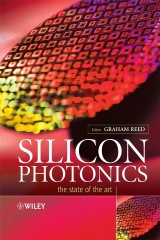Details

Silicon Photonics
The State of the Art1. Aufl.
|
125,99 € |
|
| Verlag: | Wiley |
| Format: | |
| Veröffentl.: | 23.05.2008 |
| ISBN/EAN: | 9780470994528 |
| Sprache: | englisch |
| Anzahl Seiten: | 360 |
DRM-geschütztes eBook, Sie benötigen z.B. Adobe Digital Editions und eine Adobe ID zum Lesen.
Beschreibungen
Silicon photonics is currently a very active and progressive area of research, as silicon optical circuits have emerged as the replacement technology for copper-based circuits in communication and broadband networks. The demand for ever improving communications and computing performance continues, and this in turn means that photonic circuits are finding ever increasing application areas. This text provides an important and timely overview of the ‘hot topics’ in the field, covering the various aspects of the technology that form the research area of silicon photonics. <p>With contributions from some of the world’s leading researchers in silicon photonics, this book collates the latest advances in the technology. <i>Silicon Photonics: the State of the Art</i> opens with a highly informative foreword, and continues to feature: </p> <ul> <li>the integrated photonic circuit;</li> <li>silicon photonic waveguides; </li> <li>photonic bandgap waveguides;</li> <li>mechanisms for optical modulation in silicon;</li> <li>silicon based light sources;</li> <li>optical detection technologies for silicon photonics;</li> <li>passive silicon photonic devices;</li> <li>photonic and electronic integration approaches;</li> <li>applications in communications and sensors.</li> </ul> <p><i>Silicon Photonics: the State of the Art</i> covers the essential elements of the entire field that is silicon photonics and is therefore an invaluable text for photonics engineers and professionals working in the fields of optical networks, optical communications, and semiconductor electronics. It is also an informative reference for graduate students studying for PhD in fibre optics, integrated optics, optical networking, microelectronics, or telecommunications.</p>
Foreword. <p>About the Editor.</p> <p>List of Contributors.</p> <p>Acknowledgements.</p> <p>Chapter 1. Introduction: The Opto-Electronic Integrated Circuit (Richard Soref).</p> <p>Chapter 2. Silicon Photonic Waveguides (G. Z. Mashanovich, G. T. Reed, B. D. Timotijevic, and S. P. Chan).</p> <p>Chapter 3. Silicon Based Photonic Crystal Structures: From Design to Realization (Dennis W. Prather, Shouyuan Shi, Janusz Murakowski, Garrett Schneider, Ahmed Sharkawy, Caihua Chen, and BingLin Miao).</p> <p>Chapter 4. Optical Modulators in Silicon Photonic Circuits (G. T. Reed, F .Y. Gardes, G. Z. Mashanovich, and C. E. Png).</p> <p>Chapter 5. Silicon Lasers (Bahram Jalali, Dimitris Dimitropoulos, Varun Raghunathan, and Sasan Fathpour).</p> <p>Chapter 6. Optical Detection Technologies for Silicon Photonics (A. P. Knights and J. D. B. Bradley).</p> <p>Chapter 7. Passive Silicon Photonic Devices (Ansheng Liu, Nahum Izhaky, and Ling Liao).</p> <p>Chapter 8. Integration (Cary Gunn).</p> <p>Chapter 9. Silicon Photonic Applications (Richard Jones, Haisheng Rong, Hai-Feng Liu, and Mario Paniccia).</p> <p>Index.</p>
<b>Graham Reed</b> is Professor of Optoelectronics and Head of Department, Engineering, at the University of Surrey in the UK. He graduated in 1983 with a First Class Honours degree in Electronic and Electrical Engineering. Subsequently he obtained a PhD in Integrated Optics in 1987. After a brief period as leader of the Electro-Optics Systems Group at ERA Technology Ltd, he joined the University of Surrey in 1989, where he established the Silicon Photonics group. As such this was one of the pioneering groups in silicon photonics, and has made a significant impact upon the state of the art. The group is currently the leading group in the UK in this field, and Professor Reed is acknowledged as the individual who initiated research on silicon photonic circuits and devices in the UK. The work has been carried out with collaborators from all around the world, both from academic and industrial institutions. Professor Reed has published extensively in the international scientific literature, has contributed presentations to numerous international conferences both as a submitting and an invited speaker, and has served on a variety of international committees.
Silicon photonics is currently a very active and progressive area of research, as silicon optical circuits have emerged as the replacement technology for copper-based circuits in communication and broadband networks. The demand for ever improving communications and computing performance continues, and this in turn means that photonic circuits are finding ever increasing application areas. this text provides an important and timely overview of the 'hot topics' in the field, covering the various aspects of the technology that form the research area of silicon photonics. <p>With contributions from some of the world's leading researchers in silicon photonics, this book collate the latest advances in the technology. Silicon Photonics: the State of the Art opens with highly informative foreword, and continues to feature:</p> <ul> <li> <div>the integrated photonic circuit;</div> </li> <li> <div>silicon photonic waveguides;</div> </li> <li> <div>photonic bandgap waveguides;</div> </li> <li> <div>mechanisms for optical modulation in silicon;</div> </li> <li> <div>silicon-based light sources;</div> </li> <li> <div>optical detecting technologies for silicon photonics;</div> </li> <li> <div>passive silicon photonic devices;</div> </li> <li> <div>photonic and electronic integration approaches;</div> </li> <li> <div>application in communications and sensors.</div> </li> </ul> <p>Silicon Photonics: the State of the Art covers the essential elements of the entire field of silicon photonics, and is therefore an invaluable text for photonics engineers and professionals working with optical networks, optical communications, and semiconductor electronics. It is also an informative reference for graduate students studying in fibre optics, integrated optics, optical networking, microelectronics, or telecommunications.</p>


















